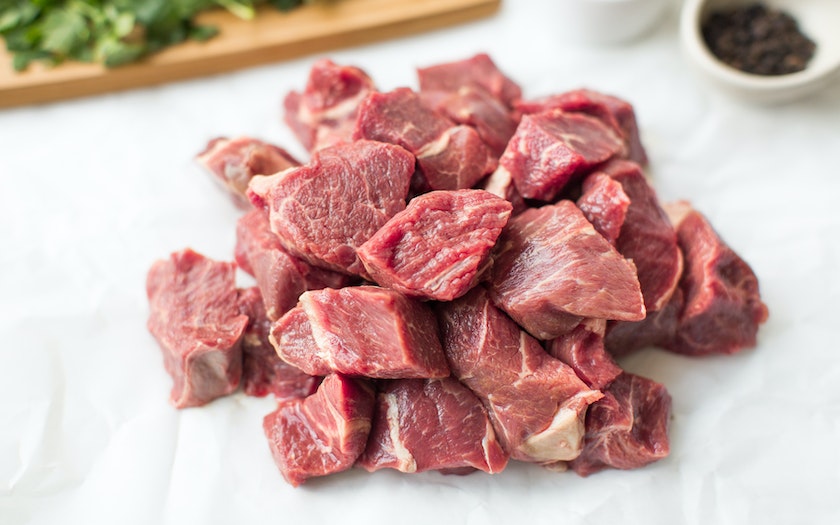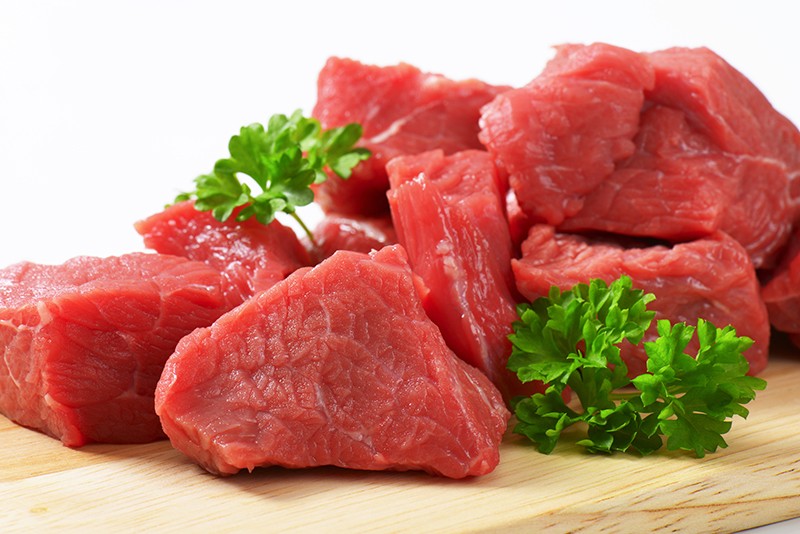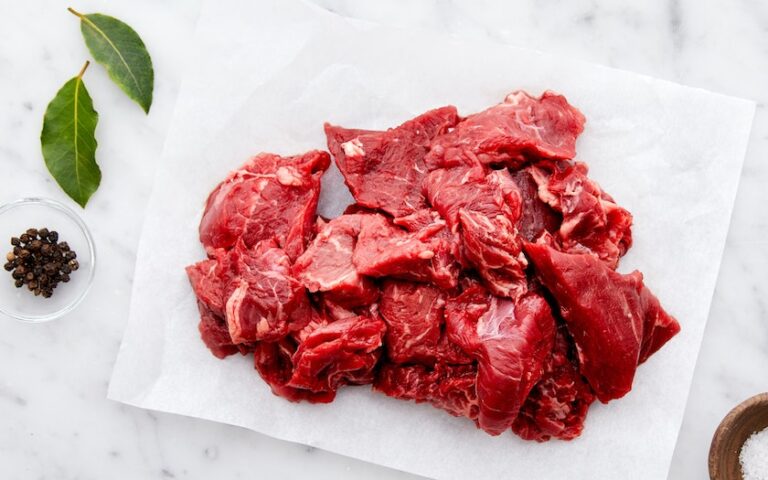Yes, stew meat can be pink. The color of meat, including stew meat, can vary based on factors such as the animal’s age, diet, cooking method, and the presence of additives like nitrates. It’s important to ensure that the internal temperature of the stew meat reaches a safe level to kill any harmful bacteria.
Also, using a meat thermometer is a reliable way to check if the meat is cooked to a safe temperature, typically 145°F (63°C) for beef and 165°F (74°C) for poultry.
Factors Influencing Meat Color in Stews

Type of Meat:
- Different types of meat exhibit varying natural colors. For example, beef tends to be more red, while pork and lamb may have a lighter pink hue. The inherent color of the meat influences the final appearance of the stew.
- Cooking Time:
- The duration of cooking plays a significant role in the color development of meat. Prolonged cooking, especially in slow-cooking methods, may result in a more uniform and deeper color as the meat fibers break down and release more pigments.
- Cooking Method:
- Stovetop cooking may lead to quicker browning, while slow cookers and ovens allow for a more gradual and even color development. Searing meat before stewing can also affect the final color by creating a Maillard reaction.
- Temperature:
- Higher temperatures promote the Maillard reaction, which contributes to browning. However, excessively high temperatures can also lead to overcooking and dryness.
- Oxygen Exposure:
- When meat is exposed to air, myoglobin—the pigment responsible for the red color undergoes oxidation and may turn brown. Proper packaging and storage can minimize oxygen exposure.
- pH Levels:
- Acidic ingredients, such as tomatoes or wine, may affect the stability of pigments and contribute to color changes during cooking.
- Myoglobin Content:
- Variations in myoglobin content among different cuts of meat can lead to differences in color. Muscles that are used more frequently may contain more myoglobin, resulting in a darker color even when cooked to the same level of doneness.
- Meat Quality:
- The quality of the meat, including factors like freshness and marbling, can impact its color. Fresh, high-quality meat is more likely to retain its natural color during cooking.
The Role of Internal Temperature
Understanding and managing internal temperature is paramount in the preparation of stewed meat. Ensuring safe minimum internal temperatures is essential, with variations depending on the type of meat ground meats at 160°F (71°C) and whole cuts like steaks at 145°F (63°C) for beef.
Moreover, cooking methods influence temperature requirements; slow cooking may exceed safety thresholds to enhance tenderness. The relationship between temperature and meat color is crucial, impacting visual appeal through processes like the Maillard reaction at higher temperatures.
Achieving uniform doneness in stewed meat, often cut into smaller pieces, requires vigilant internal temperature monitoring to prevent undercooked or overcooked sections. Adhering to recommended temperatures is crucial for eliminating pathogens and ensuring food safety, preventing the risks associated with undercooked meat.
Conversely, monitoring it helps avoid overcooking, preserving the desired juiciness and tenderness. The use of food thermometers is indispensable for accurate measurements, offering a reliable method to balance safety and quality.
While it is a critical factor, a comprehensive approach to assessing doneness includes visual and sensory indicators such as color, texture, and juiciness. Combining these elements ensures a holistic understanding, contributing to the successful preparation of stewed meat with both safety and quality in mind.
Meat Color Changes During Cooking
When you cook meat, its color changes as it goes through different stages. Initially, raw meat has a pink or red color because of a protein called myoglobin. As you apply heat during cooking, myoglobin reacts and, along with other processes like the Maillard reaction, gives the meat a brown color, which many people find appetizing.
As the cooking continues, the meat might turn from red to brown. This change happens because myoglobin transforms into metmyoglobin due to exposure to oxygen and heat. The time you cook, the method you use, and how much the meat is exposed to air all affect its final color.
Further, understanding these color changes is important for cooks. Not only does it make the dish look good, but it also helps you know when the meat is cooked just right. So, the next time you’re cooking, pay attention to how the color of the meat evolves it’s like a colorful guide telling you about the delicious transformation happening in your kitchen.
Common Misconceptions About Pink Meat
| Misconception | Reality |
| Pink meat always means it’s undercooked. | Meat color is not solely indicative of doneness; some meats can be safe with a pink hue. |
| Meat must be completely devoid of pink to be safe. | Internal temperature is the primary indicator of safety; slight pinkness may still be safe. |
| All cuts of the same meat should have the same color. | Different cuts may vary in color due to variations in myoglobin content and thickness. |
| Pink juices from meat indicate the presence of blood. | The liquid is not blood but a mixture of water and myoglobin; red or pink tinge doesn’t mean undercooked meat. |
| Everyone has the same preferences for meat color. | Preferences vary; some prefer slightly pink meat, while others prefer a more well-done appearance. |
| Marinades and seasonings don’t affect meat color. | Ingredients like acidic marinades can influence meat color, even when cooked to the proper internal temperature. |
| Frozen meat’s pink color indicates a lack of freshness. | Freezing can preserve meat color, and pinkness doesn’t necessarily correlate with quality or safety. |
Ensuring Meat Safety in Stews
Here’s a comprehensive guide on key practices to maintain meat safety in stews:
- Selecting Fresh Meat:
- Start with fresh, high-quality meat. Check for proper packaging, inspect the color (which can vary by meat type), and ensure it has been stored at appropriate temperatures.
- Thawing Safely:
- If using frozen meat, thaw it safely in the refrigerator, under cold running water, or in the microwave. Avoid thawing at room temperature to prevent bacterial growth.
- Clean and Sanitize Utensils and Surfaces:
- Wash hands, utensils, and surfaces thoroughly before and after handling raw meat to prevent cross-contamination. Use separate cutting boards for raw meat and other ingredients.
- Safe Marinating:
- If marinating meat before stewing, do it in the refrigerator to slow bacterial growth. Discard any leftover marinade that came into contact with raw meat.
- Cooking to Safe Temperatures:
- Use a food thermometer to ensure meat reaches the recommended internal temperature for safety. Different meats have varying minimum safe temperatures (e.g., 165°F/74°C for poultry, 145°F/63°C for beef).
- Consistent Stirring and Cooking:
- Ensure the stew reaches a rolling boil to guarantee that all parts of the dish, especially large meat pieces, reach the desired temperature. Stir the stew regularly for uniform heat distribution.
- Proper Storage:
- Refrigerate or freeze leftovers promptly. Bacteria multiply rapidly at room temperature, so storing stew in the refrigerator within two hours of cooking is crucial.
- Reheating Safely:
- When reheating stew, make sure it reaches an internal temperature of at least 165°F (74°C). Reheat only the amount you plan to consume to avoid repeated cooling and reheating.
- Monitoring Shelf Life:
- Pay attention to the shelf life of cooked stews. Consume or freeze them within a recommended timeframe to prevent spoilage and reduce the risk of foodborne illness.
- Personal Hygiene:
- Emphasize good personal hygiene practices, such as proper handwashing, to reduce the risk of contaminating the stew during preparation and serving.
- Avoiding Cross-Contamination:
- Keep raw meat separate from ready-to-eat foods. Use separate utensils and cutting boards for meat and vegetables. Wash hands and surfaces thoroughly after handling raw meat.
- Quality of Ingredients:
- Lastly, make sure that all ingredients, including vegetables and broth, are fresh and of high quality. Contaminated or spoiled ingredients can compromise the safety of the entire dish.
Consumer Preferences and Cultural Influences

| Aspect | Consumer Preferences | Cultural Influences |
| Ingredient Selection | Individuals choose ingredients based on personal tastes and preferences. | Culinary traditions dictate ingredient choices; cultural heritage influences flavors. |
| Spice and Flavor Profiles | Personal taste preferences guide the amount and type of spices used. | Culinary traditions define specific spice combinations unique to each culture. |
| Texture and Consistency | Preferences range from hearty and chunky to smoother, velvety stews. | Traditional stews in different cultures are known for specific textures and consistencies. |
| Meat Doneness | Varies based on personal preferences, ranging from tender to firmer textures. | Cultural norms play a role in determining the preferred doneness of meat in stews. |
| Serving Accompaniments | Choices such as rice, bread, or potatoes reflect individual dining preferences. | Cultural traditions often prescribe specific side dishes that complement stews. |
| Presentation and Garnishes | Aesthetic preferences influence the visual appeal of stew presentation. | Cultural traditions guide the art of garnishing and presenting stews in distinctive ways. |
| Occasions and Rituals | Special occasions or personal rituals impact recipe choices and preparation effort. | Cultural celebrations often involve the preparation of specific traditional stews. |
FAQ’s
Q: How do you know when stew meat is done?
A: Follow your recipe’s timing guidelines, and stew meat is done when it becomes fork-tender.
Q: Is it OK to eat pink meat?
A: Yes,For solid cuts like steak, pink meat is generally safe as harmful bacteria are typically on the surface and eliminated during cooking.
Q: Can you eat rare stew meat?
A:No, It’s not recommended; the USDA advises against consuming raw or undercooked meat due to potential bacteria.
Q: Is it okay if steak is a little pink?
A: A slight pink center, as in medium-rare or medium, is generally safe if handled and cooked properly.
Q: Can beef stew meat be undercooked?
A: Yes, undercooking stew meat, especially tough cuts like chuck, can result in toughness. Cook low and slow for tenderness.
Q: Will stew meat soften as it cooks?
A: Yes, stew meat softens as it cooks, especially with long, slow cooking in a Dutch oven or slow cooker.
Q: What meat can you not eat pink?
A: Poultry (chicken, turkey, duck, goose, liver) and pork should be cooked until juices run clear without any pink or red meat inside.
Q: Why is my raw meat pink?
A: Myoglobin, a protein responsible for the red color in meat, can cause the outer part of ground meat to appear pink; this is normal.
Q: Can beef stew meat be red?
A: Yes, browned stew meat may still appear red/pink inside as the goal is to brown the surface, not fully cook.
Q: Why not to use stew meat?
A: Mixed stew meat from different muscle groups can cook unevenly, resulting in some tender and some tough bites.
Q: How long to let stew meat cook?
A: Cook stew meat low and slow for approximately two hours for tender results.
Q: How pink is too pink for steak?
A: If a medium-rare steak reaches an internal temperature of 145°F and rests for three minutes, it’s safe, even if the center is pink.
Q: Can cooked steak still be pink?
A: Yes, small amounts of carbon monoxide or myoglobin can cause cooked steak to retain a pink color, usually on the surface.
Conclusion
The color of stew meat can vary, and it is not uncommon for it to have a pinkish hue even after cooking. Factors such as the age of the animal, its diet, cooking methods, and the presence of additives contribute to the variation in meat color.
However, it is crucial to prioritize meat safety by ensuring that stew meets the recommended internal temperatures, as determined by the type of meat used.
Also, using a meat thermometer and following proper cooking guidelines helps guarantee a safe and enjoyable dining experience. Remember that a pink color alone does not necessarily indicate undercooking; adherence to recommended temperatures remains the key to safety and deliciously prepared stew meat.

